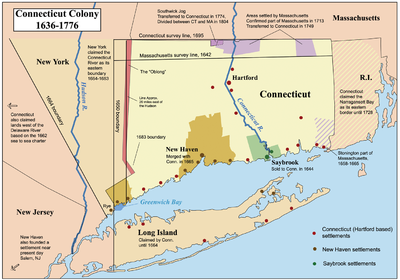History of Connecticut
[1][2] Reverend Thomas Hooker and John Haynes led a group of about 100 who, in 1636, founded the settlement of Hartford, named for Stone's place of birth: Hertford, in England.
By 1623, the new Dutch West India Company regularly traded for furs there and ten years later they fortified it for protection from the Pequot Indians, as well as from the expanding English colonies.
In 1631, the Earl of Warwick granted a patent to a company of investors headed by William Fiennes, 1st Viscount Saye and Sele, and Robert Greville, 2nd Baron Brooke.
On January 14, 1639, freemen from these three settlements ratified the "Fundamental Orders of Connecticut" in what John Fiske called "the first written constitution known to history that created a government.
According to the 1650 Treaty of Hartford with the Dutch, the western boundary of Connecticut ran north from the west side of Greenwich Bay "provided the said line come not within 10 miles (16 km) of Hudson River."
The Governor of New York issued arrest warrants for residents of Greenwich, Rye, and Stamford, and founded a settlement north of Tarrytown in what Connecticut considered part of its territory in May 1682.
In 1754 the Susquehannah Company of Windham, Connecticut, obtained from a group of Native Americans a deed to a tract of land along the Susquehanna River which covered about one-third of present-day Pennsylvania.
Pennsylvania did not accede to the ruling, however, and open warfare broke out between them and Connecticut, ending with an attack in July 1778, which killed approximately 150 of the settlers and forced thousands to flee.
After complex litigation, in 1786, Connecticut dropped its claims by a deed of cession to Congress, in exchange for freedom for war debt and confirmation of the rights to land further west in present-day Ohio, which became known as the Western Reserve.
The legislature, controlled by the Old Lights, in 1742 passed an "Act for regulating abuses and correcting disorder in ecclesiastical affairs" that sharply restricted ministers from leading revivals.
The Redding encampment allowed Putnam's soldiers to guard the replenished supply depot in Danbury and support any operations along Long Island Sound and the Hudson River Valley.
Soldiers at the Redding camp endured supply shortages, cold temperatures and significant snow, with some historians dubbing the encampment "Connecticut's Valley Forge.
"[28] The state was also the launching site for a number of raids against Long Island orchestrated by Samuel Holden Parsons and Benjamin Tallmadge, and provided soldiers and material for the war effort, especially to Washington's army outside New York City.
Starting in the 1830s, and accelerating when Connecticut abolished slavery entirely in 1848, African Americans from in- and out-of-state began relocating to urban centers for employment and opportunity, forming new neighborhoods such as Bridgeport's Little Liberia.
[38][39] Connecticut's extensive industry, its dense population, its flat terrain, its proximity to metropolitan centers, and the wealth of its residents made it favorable grounds for railroad building, starting in 1839.
The goal, richly supported by Morgan's financing, was to purchase and consolidate the main railway lines of New England, merge their operations, lower their costs, electrify the heavily used routes, and modernize the system.
The New Haven purchased 50 smaller companies, including steamship lines, and built a network of light rails (electrified trolleys) that provided inter-urban transportation for all of southern New England.
[44] The Republicans dominated state politics after 1896, and had a lock on the legislature where the one-town, one representative rule guaranteed that small rural towns could easily outvote the growing cities.
When World War I broke out in 1914, Connecticut's large machine industry received major contracts from British, Canadian, and French interests, as well as the U.S. forces.
The Ku Klux Klan had a small anti-Catholic and anti-immigrant following in Connecticut in the 1920s, reaching about 15,000 members before its collapse nationwide in 1926 following scandals involving top leaders.
The hero of the movement was Yale English professor Governor Wilbur Lucius Cross (1931–1939), who emulated much of Franklin D. Roosevelt's New Deal policies by creating new public services, contributing to infrastructure projects, and instituting a minimum wage.
Roosevelt's call for America to be the Arsenal of Democracy led to remarkable growth in munition-related industries, such as airplane engines, radio, radar, proximity fuzes, rifles, and a thousand other products.
Connecticut's suburbs thrived as people moved to newer housing via subsidized highways, while its cities peaked in the 1950s and then began a slow downhill slide as population spread into widely dispersed regions.
Construction of major highways such as the Connecticut Turnpike, subsidized by federal investment, resulted in former small towns becoming sites for large-scale residential and retail development, a trend that continues to this day, with offices also moving to new locations.
Connecticut offered ample inexpensive office space, high quality of life to people who did not want to live in New York City, and excellent public schools.
The Republican Party was mildly liberal, typified by Senator Prescott Bush, a wealthy Yankee whose son and grandson were later each elected as president from their new conservative base in Texas.
Connecticut had some difficulty in projecting its identity, with no big-league sports teams and its media markets dominated by outside television stations in New York, Providence, Rhode Island, and Springfield, Massachusetts.
Bailey's usual success in dictating the state ticket was upset in 1970, when the Republican gubernatorial candidate, Congressman Thomas Meskill, defeated a lackluster Democrat.
In July 2009, the Connecticut legislature overrode a veto by Governor M. Jodi Rell to pass SustiNet, the first significant public-option health care reform legislation in the nation.
[78] Two months later in late October, the so-called "Halloween nor'easter" dropped extensive snow onto trees in northern Connecticut that still had foliage, resulting in a significant number of snapped branches and trunks that damaged property and power lines, with some areas not seeing electricity restored for 11 days.









